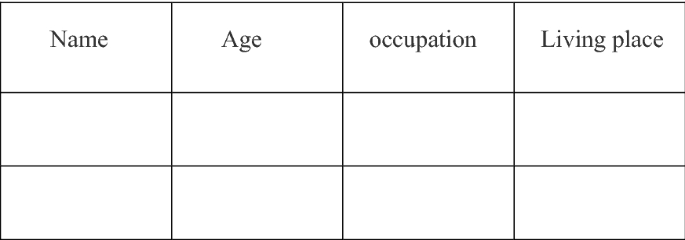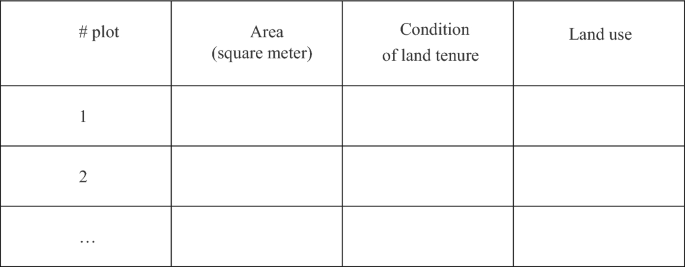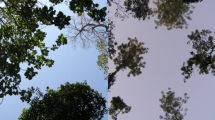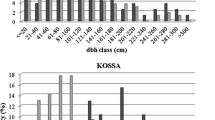Abstract
Coffee-agroforestry includes biodiversity conservation in tropical regions. The least economically valuable yet widely cultivated “robusta” coffee was studied in Panama, considering management practices and tree diversity. Fifty households were interviewed and a detailed tree census was conducted in 29 coffee plots owned by 13 households. Besides C. canephora there were 638 stems of 90 species in 41 plant families. Coffee plantings ≤ 10 years of age had higher tree diversity. With different degrees of management and original forest conditions, the coffee-agroforestry landscape was not uniform. Local vegetation was partly conserved. Farmers did not focus directly on productivity but instead emphasized flexible use and management, with moderate labor input, under changing socio-economic circumstances. Such rustic management, with attitudes and actions not governed by immediate monetary benefit, influenced biodiversity and rural life.



Similar content being viewed by others
Availability of data and material
Data are available on request from the corresponding author.
References
Adams C, Munari LC, Van Vliet N et al (2013) Diversifying incomes and losing landscape complexity in Quilombola shifting cultivation communities of the Atlantic rainforest (Brazil). Hum Ecol 41:119–137. https://doi.org/10.1007/s10745-012-9529-9
Aguilar S, Condit R (2001) Use of native tree species by a Hispanic community in Panama. Econ Bot 55:223–235. https://doi.org/10.1007/BF02864560
Aguilar-Støen M, Angelsen A, Stølen K et al (2011) The emergence, persistence, and current challenges of coffee forest gardens: A case study from Candelaria Loxicha, Oaxaca, Mexico. Soc Natur Resour 24:1235–1251. https://doi.org/10.1080/08941920.2010.540309
Altieri MA, Nicholls CI (2017) Agroecology: a brief account of its origins and currents of thought in Latin America. Agroecol Sustain Food Syst 41:231–237. https://doi.org/10.1080/21683565.2017.1287147
Bacon CM, Méndez VE, Gómez MEF et al (2008) Are sustainable coffee certifications enough to secure farmer livelihoods? The millenium development goals and Nicaragua’s Fair Trade cooperatives. Globalizations 5:259–274. https://doi.org/10.1080/14747730802057688
Bacon CM, Getz C, Kraus S et al (2012) The social dimensions of sustainability and change in diversified farming systems. Ecol Soc 17:41. https://doi.org/10.5751/ES-05226-170441
Bandeira FP, Martorell C, Meave JA et al (2005) The role of rustic coffee plantations in the conservation of wild tree diversity in the Chinantec region of Mexico. Biodivers Conserv 14:1225–1240. https://doi.org/10.1007/s10531-004-7843-2
Calvo L, Blake J (1998) Bird diversity and abundance on two different shade coffee plantations in Guatemala. Bird Conserv Int 8:297–308. https://doi.org/10.1017/S0959270900001945
Cerda R, Allinne C, Gary C et al (2017) Effects of shade, altitude and management on multiple ecosystem services in coffee agroecosystems. Eur J Agron 82:308–319. https://doi.org/10.1016/j.eja.2016.09.019
Condit R, Pérez R, Lao S et al (2017) Demographic trends and climate over 35 years in the Barro Colorado 50 ha plot. Forest Ecosystems 4:1–13. https://doi.org/10.1186/s40663-017-0103-1
Davis H, Rice R, Rockwood L et al (2019) The economic potential of fruit trees as shade in blue mountain coffee agroecosystems of the Yallahs River watershed, Jamaica WI. Agrofor Syst 93:581–589. https://doi.org/10.1007/s10457-017-0152-z
Eakin H, Tucker CM, Castellanos E et al (2014) Adaptation in a multi-stressor environment: perceptions and responses to climatic and economic risks by coffee growers in Mesoamerica. Environ Dev Sustain 16:123–139. https://doi.org/10.1007/s10668-013-9466-9
Fujisawa N (2019) Production, consumption, and culture of upland rice in Swiddens: a case study of a campesino Community in Panama. Hum Ecol 47:541–552. https://doi.org/10.1007/s10745-019-00091-x
Fujisawa N, Tanaka M, Inoue M (2012) Flexibility of coffee agroforestry with diversified shade tree composition: a case study in Panama. Tropics 21:33–46. https://doi.org/10.3759/tropics.21.33
INEC (2011) XI Censo Nacional de Población y VII de Vivienda 2010. https://www.inec.gob.pa/publicaciones/Default3.aspx?ID_PUBLICACION=355&ID_CATEGORIA=13&ID_SUBCATEGORIA=59. Accessed 13 March 2020
INEC (2016) Cosecha de café en la república, por utilización, según provincia, Comarca indígena y variedad: año agrícola 2015/16. https://www.inec.gob.pa/archivos/P7821CUADRO%20312-05.pdf. Accessed 13 March 2020
INEC (2017) Meteorología; año 2015. https://www.inec.gob.pa/publicaciones/Default3.aspx?ID_PUBLICACION=821&ID_CATEGORIA=2&ID_SUBCATEGORIA=4. Accessed 13 March 2020
Inoue M (2000) Participatory forest management. In: Edi G, Mansur F, Maman S et al (eds) Rainforest ecosystems of East Kalimantan: El Nino, drought, fire, and human impacts. Springer, Tokyo, pp 299–307
Iverson AL, Gonthier DJ, Pak D et al (2019) A multifunctional approach for achieving simultaneous biodiversity conservation and farmer livelihood in coffee agroecosystems. Biol Conserv 238:108179. https://doi.org/10.1016/j.biocon.2019.07.024
Jarvis DI, Padoch C, Cooper HD (2007) Biodiversity, Agriculture, and Ecosystem Services. In: Jarvis DI, Padoch C, Cooper HD (eds) Managing biodiversity in agricultural ecosystems. Columbia University Press, New York, pp 1–12
Jha S, Bacon CM, Philpott SM et al (2014) Shade coffee: update on a disappearing refuge for biodiversity. Bioscience 64:416–428. https://doi.org/10.1093/biosci/biu038
Lin BB (2007) Agroforestry management as an adaptive strategy against potential microclimate extremes in coffee agriculture. Agric For Meteorol 144(1):85–94. https://doi.org/10.1016/j.agrformet.2006.12.009
López-Gómez AM, Williams-Linera G, Manson RH (2008) Tree species diversity and vegetation structure in shade coffee farms in Veracruz, Mexico. Agric Ecosyst Environ 124:160–172. https://doi.org/10.1016/j.agee.2007.09.008
Méndez VE, Bacon CM, Olson M et al (2010) Agrobiodiversity and shade coffee smallholder livelihoods: a review and synthesis of ten years of research in Central America. Prof Geogr 62:357–376. https://doi.org/10.1080/00330124.2010.483638
Miranda A (2006) Características de los cultivares comerciales de café en Panamá. MIDA, Panama
Moguel P, Toledo VM (1999) Biodiversity conservation in traditional coffee systems of Mexico. Conserv Biol 13:11–21. https://doi.org/10.1046/j.1523-1739.1999.97153.x
Nair PR (1993) The history of agroforestry. An introduction to agroforestry. Kluwer Academic Publishers, Dordrecht, pp 3–12
Padrón BR, Burger K (2015) Diversification and labor market effects of the Mexican coffee crisis. World Dev 68:19–29. https://doi.org/10.1016/j.worlddev.2014.11.005
Pagiola S, Ruthenberg I (2002) Selling biodiversity in a coffee cup: shade-grown coffee and conservation in Mesoamerica. In: Bishop J, Pagiola S, Landell-Mills N (eds) Selling forest environmental services: market-based mechanisms for conservation and development. Earthscan, London, pp 103–126
Perfecto I, Rice RA, Greenberg R et al (1996) Shade coffee: a disappearing refuge for biodiversity. Bioscience 46:598–608. https://doi.org/10.2307/1312989
Philpott SM, Arendt WJ, Armbrecht I et al (2008) Biodiversity loss in Latin American coffee landscapes: Review of the evidence on ants, birds, and trees. Conserv Biol 22:1093–1105. https://doi.org/10.1111/j.1523-1739.2008.01029.x
Pineda E, Moreno C, Escobar F, Halffter G (2005) Frog, bat, and dung beetle diversity in the cloud forest and coffee agroecosystems of Veracruz, Mexico. Conserv Biol 19:400–410. https://doi.org/10.1111/j.1523-1739.2005.00531.x
Pokorny B, De Jong W (2015) Smallholders and forest landscape transitions: locally devised development strategies of the tropical Americas. Int For Rev 17:1–19. https://doi.org/10.1505/146554815814668981
Redford KH, Padoch C (eds) (1992) Conservation of neotropical forests: working from traditional resource use. Columbia University Press, Columbia
Rice RA (1999) A place unbecoming: the coffee farm of northern Latin America. Geogr Rev 89:554–579. https://doi.org/10.1111/j.1931-0846.1999.tb00234.x
Rice RA (2011) Fruits from shade trees in coffee: How important are they? Agrofor Syst 83:41–49. https://doi.org/10.1007/s10457-011-9385-4
Rivera-Núñez T, Estrada-Lugo EI, García-Barrios L et al (2020) Peasant micropower in an agrifood supply system of the Sierra Madre of Chiapas, Mexico. J Rural Stud 78:185–198. https://doi.org/10.1016/j.jrurstud.2020.06.027
Rojas M (2012) Manual de producción de café orgánico: una opción para el caficultor panameño. MIDA, Panama
Roubik DW (2002) Tropical agriculture: the value of bees to the coffee harvest. Nature 417:708. https://doi.org/10.1038/417708a
Sander L, Vandebroek I (2016) Small-scale farmers as stewards of useful plant diversity: a case study in Portland Parish, Jamaica. Econ Bot 70:303–319. https://doi.org/10.1007/s12231-016-9354-y
Samper LF, Quinones-Ruiz XF (2017) Towards a balanced sustainability vision for the coffee industry. Resources-Basel 6(2):17. https://doi.org/10.3390/resources6020017
Schnabel F, de Melo Virginio Filho E, Xu S et al (2018) Shade trees: a determinant to the relative success of organic versus conventional coffee production. Agrofor Syst 92:1535–1549. https://doi.org/10.1007/s10457-017-0100-y
Shikata K (2010) The processes of creating diversity of non-cocoa tree species in cocoa agroforests of Southeastern Cameroon. Ökumene Res 1:67–90
Trujillo L (2008) Coffee-Production strategies in a changing rural landscape: a case study in central Veracruz, Mexico. In: Bacon CM, Méndez VE, Gliessman SR et al (eds) Confronting the Coffee Crisis. MIT Press, Cambridge, pp 69–98
Tucker CM, Eakin H, Castellanos EJ (2010) Perceptions of risk and adaptation: coffee producers, market shocks, and extreme weather in Central America and Mexico. Global Environ Change 20(1):23–32. https://doi.org/10.1016/j.gloenvcha.2009.07.006
Valencia V, Naeem S, García-Barrios L et al (2016) Conservation of tree species of late succession and conservation concern in coffee agroforestry systems. Agric Ecosyst Environ 219:32–41. https://doi.org/10.1016/j.agee.2015.12.004
Acknowledgements
We thank San Pedro families for their support and patience, Rolando Pérez and Salomón Aguilar of S.T.R.I. for plant identification, Maria Dominguez for support, and members of Kokage workshop for advice.
Funding
This work was funded by the Japan Society for the Promotion of Science KAKENHI Grant Numbers JP14J11204, JP16J40080, and 19K20521 and partly supported by Program II of the Research Institute for Humanity and Nature.
Author information
Authors and Affiliations
Contributions
All authors contributed to design the research. Natsuho Fujisawa and David Roubik performed Preparation, N.F. performed research, and N.F. and Makoto Inoue analyzed data. The first draft was written by N.F.. All authors read, commented, and approved the final manuscript
Corresponding author
Ethics declarations
Conflict of interest
The authors declare that they have no conflict of interest.
Code availability
Not applicable.
Additional information
Publisher's Note
Springer Nature remains neutral with regard to jurisdictional claims in published maps and institutional affiliations.
Appendices
Appendix 1:The household survey and semi-structured interview guide
-
1
Socioeconomic survey and semi-structured interview guide.
-
1.1
Family Demographics.

-
1.2
Landholdings.

-
1.3
What are the main income source activities?
-
1.4
Does your family receive some cash transfer program from the government?
-
1.5
Do you have/have you have any experience of working outside the village?
-
1.6
What kind of jobs did you have?
-
1.7
Do you have swidden plots this year? What crops do you have?
-
1.8
How much do you spend money per day/week as a general expense?
-
1.1
-
2
Survey on coffee and shade management.
-
2.1
How many coffee plots do you have?
-
2.2
The total area of coffee plots.
-
2.3
Number of lata (5-gallon bucket) harvested in the last agricultural year.
-
2.4
For what did you spend the earned money from the coffee harvest?
-
2.5
How often do you drink coffee?
-
2.1
-
3
Coffee management.
-
3.1
Number of annual maintenances on coffee plots.
-
3.2
Source of the labor force for maintenance.
-
3.3
Source of the labor force for harvest.
-
3.4
What was the purpose to use the money gained from the coffee harvest?
-
3.5
What resources do you obtain from coffee plots?
-
3.6
Please name the suitable tree for shade. Why?
-
3.7
Please name the trees that should be removed. Why?
-
3.1
-
4
Interview guides for coffee management for 13 households.
-
4.1
Who did open the plot?
-
4.2
When did the plot be formed?
-
4.3
What resources did you obtain in the last 1 year?
-
4.4
What was the previous land use?
-
4.5
Why did you choose here for the coffee plot?
-
4.6
Do you have some resources to conserve in the plot?
-
4.7
Which method do you use to perform the management of plots?
-
4.8
Which variety of coffee do you have?
-
4.1
Appendix 2
See Table 6.
Rights and permissions
About this article
Cite this article
Fujisawa, N., Roubik, D.W. & Inoue, M. Farmer influence on shade tree diversity in rustic plots of Coffea canephora in Panama coffee-agroforestry. Agroforest Syst 94, 2301–2315 (2020). https://doi.org/10.1007/s10457-020-00551-0
Received:
Accepted:
Published:
Issue Date:
DOI: https://doi.org/10.1007/s10457-020-00551-0






